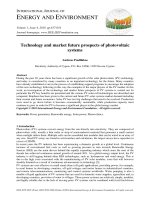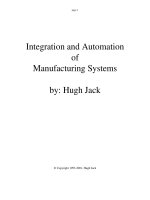- Trang chủ >>
- Khoa Học Tự Nhiên >>
- Vật lý
Technology and market future prospects of photovoltaic systems
Bạn đang xem bản rút gọn của tài liệu. Xem và tải ngay bản đầy đủ của tài liệu tại đây (175.36 KB, 18 trang )
I
NTERNATIONAL
J
OURNAL OF
E
NERGY AND
E
NVIRONMENT
Volume 1, Issue 4, 2010 pp.617-634
Journal homepage: www.IJEE.IEEFoundation.org
ISSN 2076-2895 (Print), ISSN 2076-2909 (Online) ©2010 International Energy & Environment Foundation. All rights reserved.
Technology and market future prospects of photovoltaic
systems
Andreas Poullikkas
Electricity Authority of Cyprus, P.O. Box 24506, 1399 Nicosia, Cyprus.
Abstract
During the past 20 years there has been a significant growth of the solar photovoltaic (PV) technology
and today is considered by many countries as an important technology for the future. Many countries
have already established or are in the process of establishing support programs to encourage the adoption
of this new technology following in this way the examples of the major players of the PV market. In this
work, an investigation of the technology and market future prospects of PV systems is carried out. In
particular the PV key benefits are presented and the various PV solar cell technologies are described and
compared. Emphasis has been given to the current and future PV solar systems market demand including
their current and future economics.
Solar PV has two big challenges that need to be resolved. Production
costs need to go down before it becomes economically sustainable, while production capacity must
continue to grow in order for PV to become a significant player in the global energy market.
Copyright © 2010 International Energy and Environment Foundation - All rights reserved.
Keywords: Power generation, Renewable energy, Solar power, Photovoltaics.
1. Introduction
Photovoltaic (PV) systems convert energy from the sun directly into electricity. They are composed of
photovoltaic cells, usually a thin wafer or strip of semiconductor material that generates a small current
when sunlight strikes them. Multiple cells can be assembled into modules that can be wired in an array of
any size. Small PV arrays are found in wristwatches and calculators, the largest arrays have capacities in
excess of 20MW.
In recent years the PV industry has been experiencing a dramatic growth at a global level. Continuous
increase of conventional fuel costs as well as growing pressure to turn towards Renewable Energy
Sources (RES) are the main drivers behind this rapidly expanding industry which since the start of the
decade has achieved continuous annual growth of around 30%. At a global energy output level, the PV
industry is still lagging behind other RES technologies, such as, hydropower and wind energy. This is
due to the high costs associated with the manufacturing of PV solar modules, costs that will however
steadily diminish as a result of continuous advancements in technology [5].
PV systems are cost-effective in small stand alone (off-grid) applications, providing power, for example,
to rural homes in developing countries, off-grid cottages and motor homes in industrialized countries,
and remote telecommunications, monitoring and control systems worldwide. Water pumping is also a
notable off-grid application of PV systems that are used for domestic water supplies, agriculture and, in
developing countries, provision of water to villages. These power systems are relatively simple, modular,
and highly reliable due to the lack of moving parts. PV systems can be combined with fossil fuel-driven
International Journal of Energy and Environment (IJEE), Volume 1, Issue 4, 2010, pp.617-634
ISSN 2076-2895 (Print), ISSN 2076-2909 (Online) ©2010 International Energy & Environment Foundation. All rights reserved.
618
generators in periods of little sunshine (e.g., winter at high latitudes) to form hybrid systems.
PV systems can also be tied to isolate or central grids via a specially configured inverter. Unfortunately,
without subsidies, grid connected (on-grid) applications are rarely cost-effective due to the high price of
PV modules, even if it has declined steadily since 1985 [6]. Due to the minimal maintenance of PV
systems and the absence of real benefits of economies of scale during construction, distributed generation
is the path of choice for future cost-effective on-grid applications. In distributed electricity generation,
small PV systems would be widely scattered around the grid, mounted on buildings and other structures
and thus not incurring the costs of land rent or purchase. Such applications have been facilitated by the
development of technologies and practices for the integration of PV systems into the building envelope,
which offset the cost of conventional material and/or labor costs that would have otherwise been spent.
The residential rooftop application of PVs is expected to provide the major application of the coming
decade and to provide the market growth needed to reduce prices. Large centralized solar PV power
stations able to provide low-cost electricity on a large scale would become increasingly attractive
approaching 2020.
In this work, an investigation of the technology and market future prospects of PV systems is carried out.
In particular the PV key benefits are presented and the various PV solar cell technologies are described
and compared. Emphasis has been given to the current and future PV solar systems market demand
including their current and future economics.
In section 2, the PV technology status is discussed and in section 3, the PV system types and their
benefits are described. The PV market demand is presented in section 4 including projections on PV
economics. The conclusions are summarized in section 5.
2. The PV technology
Solar energy is the energy force that sustains life on earth for all plants, animals and people. The earth
receives this energy from the sun in the form of electromagnetic waves, which the sun continually emits
into space. The earth can be seen as a huge solar energy collector receiving large quantities of this energy
which takes various forms, such as direct sunlight, heated air masses causing wind, and evaporation of
the oceans resulting as rain which can form rivers. This solar potential can be trapped directly as solar
energy (solar thermal and/or PV) and indirectly as wind, biomass and hydroelectric energy.
Solar energy is a renewable source that is inexhaustible and is locally available. It is a clean energy
source that allows for local energy independence. The sun’s power that is reaching the earth annually is
typically about 1000W/m
2
, although availability varies with location and time of year. Capturing solar
energy typically requires equipment with a relatively high initial capital cost. However, in some cases,
over the lifetime of the solar equipment, these systems can prove to be cost competitive, as compared to
conventional energy technologies.
The solar energy industry is divided into mainly two markets, the PV market and the solar thermal
market. The solar thermal technology uses the heat radiated from the sun, for purposes such as heating
water or power generation. On the other hand PV solar cells use the properties of particular
semiconducting materials to convert sunlight energy to electricity. The PV industry is far larger than the
solar thermal market.
Solar electricity produced by PV solar cells is one of the most promising options yet identified for
sustainably providing the world's future energy requirements. Although the technology has, in the past,
been based on the same silicon wafers as used in microelectronics, a transition is in progress to a second
generation of a potentially much lower-cost thin-film technology. Cost reductions from both increased
manufacturing volume and such improved technology are expected to continue to drive down PV cell
prices over the coming two decades to a level where the cells can provide competitively priced electricity
on a large scale [19].
2.1 Basics of PVs
Electricity can be produced from sunlight through a process called “photovoltaics”, which can be
applied, in either a centralized or decentralized way. “Photo” refers to light and “voltaic” to electrical
voltage. The term describes a solid-state electronic cell that produces direct current (DC) electrical
energy from the radiant energy of the sun.
The basic steps from the PV solar cell to a fully operating PV system are presented in Figure 1. PV solar
cells are made of semi-conducting material, most commonly silicon, coated with special additives. When
light strikes the cell, electrons are knocked and become loose from the silicon atoms and flow in an in-
International Journal of Energy and Environment (IJEE), Volume 1, Issue 4, 2010, pp.617-634
ISSN 2076-2895 (Print), ISSN 2076-2909 (Online) ©2010 International Energy & Environment Foundation. All rights reserved.
619
built circuit producing electricity. Individual solar cells can be connected in series and in parallel to
obtain desired voltages and currents. These groups of cells are packaged into standard modules that
protect the cells from the environment. PV modules are extremely reliable since they are solid state and
there are no moving parts.
Figure 1. Basic steps from PV cell to PV system
PV systems are made up of a variety of components, which aside from the modules, may include
conductors, fuses, batteries, inverters, etc. Components will vary, however, depending on the application.
PV systems are modular by nature, meaning that systems can be expanded and components easily
repaired or replaced if needed. PV systems are cost effective for many remote power applications, as well
as for small stand-alone power applications in proximity to the existing electricity grid.
2.2 Principle of operation
A cell is created when a positively charged (p-type) layer of silicon is placed against a negatively
charged (n-type) to create a diode for the flow of electrons. When silicon is exposed to light, electrical
charges are generated. Referring to Figure 2, light entering the cell through the gaps between the top
contacts metal gives up its energy by temporarily releasing electrons from the covalent bonds holding the
semiconductor together; at least this is what happens for those photons with sufficient energy [12]. The
p-n junction within the cell ensures that the now mobile charge carriers of the same polarity all move off
in the same direction. These electrical charges are conducted away as DC power by placing metal
contacts on the top and bottom of a PV cell. If an electrical load is connected between the top and rear
contacts to the cell, electrons will complete the circuit through this load, constituting an electrical current
in it. Energy in the incoming sunlight is thereby converted into electrical energy.
The cell operates as a “quantum device”, exchanging photons for electrons. Ideally, each photon of
sufficient energy striking the cell causes one electron to flow through the load. In practice, this ideal is
seldom reached. Some of the incoming photons are rejected from the cell or get absorbed by the metal
contacts (where they give up their energy as heat). Some of the electrons excited by the photons relax
back to their bound state before reaching the cell contacts and thereby the load.
The electrical power consumed by the load is the product of the electrical current supplied by the cell and
the voltage across it. Each cell can supply current at a voltage between 0.5V-1V, depending on the
particular semiconductor used for the cell. Since the electrical output of a single cell is quite small to
generate sufficient amount of electricity multiple cells are connected together to form a module or a
panel [13].
The PV module is the primary component of PV system and any number of PV modules can be
connected to generate the desired amount of electricity. The modular structure of a PV system is
considered an advantage since at any instant a new module can be incorporated to the system to satisfy
the new electricity requirement. Different PV modules vary in structure; however, they generally include
the following elements: (a) glass cover in which the transparent glass cover is placed over the PV cell for
protection reasons, (b) anti-reflective sheet which is used to enhance the effect of the glass cover while
the anti-reflective coating is used to block reflection, (c) cell and (d) frame and panel backing which are
used to hold all the pieces together and protect the PV cell from damage [22].
cell module system
International Journal of Energy and Environment (IJEE), Volume 1, Issue 4, 2010, pp.617-634
ISSN 2076-2895 (Print), ISSN 2076-2909 (Online) ©2010 International Energy & Environment Foundation. All rights reserved.
620
Figure 2. PV solar cell operating principle
2.3 PV technologies
The choice of the semiconductor defines the PV technology. There are two main PV technologies, such
as, crystalline silicon solar cells and thin film solar cells as described in the following sections.
2.3.1 Crystalline silicon solar cells
The technology used to make most of the crystalline silicon solar cells, fabricated so far, borrows heavily
from the microelectronics industry and is known as silicon wafer technology. The silicon source material
is extracted from quartz, although sand would also be a suitable material. The silicon is then refined to
very high purity and melted. From the melt, a large cylindrical single crystal is drawn. The crystal, or
“ingot”, is then sliced into circular wafers, less than 0.5mm thick, like slicing bread from a loaf.
Sometimes this cylindrical ingot is “squared-off” before slicing so the wafers have a “quasi-square”
shape that allows processed cells to be stacked more closely side-by-side. Most of this technology is
identical to that used in the much larger microelectronics industry, benefiting from the corresponding
economies of scale. Since good cells can be made from material of lower quality than that used in
microelectronics, additional economies are obtained by using off-specification silicon and off-
specification silicon wafers from this industry.
The first step in processing a wafer into a cell is to etch the wafer surface with chemicals to remove
damage from the slicing step. The surface of crystalline wafers is then etched again using a chemical that
etches at different rates in different directions through the silicon crystal. This leaves features on the
surface, with the silicon structure that remains determined by crystal directions that etch very slowly. The
p-n junction is then formed. The impurity required to give p-type properties (usually boron) is introduced
during crystal growth, so it is already in the wafer. The n-type impurity (usually phosphorus) is now
allowed to seep into the wafer surface by heating the wafer in the presence of a phosphorus source.
Crystalline silicon solar cells hold 93% of the market. Despite the fact that it is a relatively poor light
absorbing semiconducting material, over the years it has been the primary raw material used in most
solar PV cells due to its ability to yield stable and efficient cells, with efficiencies between 11-16% in
terms of converting sunlight energy to electrical energy [23].
There are two types of crystalline silicon solar cells that are used in the industry, such as, (a)
monocrystalline silicon cells (single-Si) and (b) multicrystalline silicon cells (multi-Si or poly-Si).
The monocrystalline silicon cell is made using cells saw-cut from a single cylindrical crystal of silicon.
The main advantage of the monocrystalline silicon cells is the high efficiency which is around 15%. The
multicrystalline silicon cell is made by sawing a cast block of silicon first into bars and then into wafers.
Multicrystalline cells are cheaper to manufacture than monocrystalline ones due to the simpler
manufacturing process. However they are slightly less efficient than the monocrystalline with average
efficiency of approximately 12%.
In general crystalline silicon solar cells have a relatively high production cost and subsequently high
selling price. Moreover, its dependence on purified silicon as the key raw material creates additional
light
n-type
p-type
International Journal of Energy and Environment (IJEE), Volume 1, Issue 4, 2010, pp.617-634
ISSN 2076-2895 (Print), ISSN 2076-2909 (Online) ©2010 International Energy & Environment Foundation. All rights reserved.
621
difficulty since there is global shortage of the material. The relative high costs result from the complex
and numerous production steps involved in wafer and cell manufacturing and the large amount of highly
purified silicon feedstock required.
2.3.2 Thin-film solar cells
Due to the high production cost of the crystalline silicon wafers, the PV industry has been seeking for
alternative ways of manufacturing PV solar cells using cheaper materials such as the thin-film solar cells.
Figure 3. Thin-film technology approach
In the thin-film technology approach, thin layers of semiconductor material are deposited onto a
supporting substrate, or superstrate, such as a large sheet of glass as indicated in Figure 3. Typically, less
than a micron (µm) thickness of semiconductor material is required, 100-1000 times less than the
thickness of silicon wafer. Reduced material use with associated reduced costs is a key advantage.
Another advantage is that the unit of production, instead of being a relatively small silicon wafer,
becomes much larger, for example, as large as a conveniently handled sheet of glass might be. This
reduces manufacturing costs.
Silicon is one of the few semiconductors inexpensive enough to be used to make solar cells from self-
supporting wafers. However, in thin-film form, due to the reduced material requirements, virtually any
semiconductor can be used. Since semiconductors can be formed not only by elemental atoms, such as
silicon, but also from compounds and alloys involving multiple elements, there is essentially an infinite
number of semiconductors from which to choose. At present, solar cells made from different thin-film
technologies are either available commercially, or close to being so, such as, cadmium telluride (CdTe),
copper indium diselenide (CIS), amorphous silicon (a-Si) and thin-film silicon (thin film-Si) [20].
Amorphous silicon is in commercial production while the other three technologies are slowly reaching
the market. Over the coming decade, one of the above technologies is expected to establish its superiority
and attract investment in major manufacturing facilities that will sustain the downward pressure on cell
prices. As each of these thin-film technologies has its own strengths and weaknesses, the likely outcome
is not clear at present [21].
Table 1. Comparison of various most common PV technologies [24]
Technology Typical efficiency* Maximum efficiency* obtained
(laboratory)
Cost
single-Si 12-16% 24.0% Expensive
poly-Si 11-14% 18.6% Less expensive
a-Si 6-7% 12.7% Reduced cost
* solar energy to electrical energy conversion efficiency
Thin-film panels have several important drawbacks. What they gain in cost savings and flexibility they
lose in efficiency resulting in the lowest efficiency of any current PV technology at approximately 6-7%.
The main interest in these technologies rises from the fact that they can be manufactured by relatively
rear cover
thin-film
glass superstrate
International Journal of Energy and Environment (IJEE), Volume 1, Issue 4, 2010, pp.617-634
ISSN 2076-2895 (Print), ISSN 2076-2909 (Online) ©2010 International Energy & Environment Foundation. All rights reserved.
622
inexpensive industrial processes, in comparison to crystalline silicon technologies yet they offer typically
higher module efficiency than amorphous silicon.
2.4 Overall comparison
An overall comparison of the efficiency and the cost of the various most common PV solar cell
technologies are tabulated in Table 1. In general as the efficiency of PV solar cells increases their cost
increases too.
3. PV systems
The primary articles of commerce in the PV market are the PV modules which are integrated into
systems designed for specific applications. The components added to the module constitute the “balance
of system” or BOS. Balance of system components can be classified into four categories (see also Figure
1): (a) batteries which store electricity to provide energy on demand at night or on overcast days, (b)
controllers which can manage the energy storage to the battery and deliver power to the load, (c)
inverters which are required to convert the DC power produced by the PV module into alternate current
(AC) power and (d) structure which is required to mount or install the PV modules and other components
[11].
Not all systems will require all these components. For example in systems where no AC load is present
an inverter is not required. For grid connected systems, the utility grid acts as the storage medium and
batteries are not required. Some systems also require other components which are not strictly related to
PVs. Some stand alone systems, for example, include a fossil fuel generator that provides electricity
when the batteries become depleted; and water pumping systems require a DC or AC pump [2].
3.1 PV modules
To make modules, PV solar cell manufacturers assemble the cells into modules or sell them to module
manufacturers for assembly. Because the first important applications of PV involved battery charging,
most modules in the market are designed to deliver DC power at slightly over 12V. A typical crystalline
silicon PV solar module consists of a series circuit of 36 cells, encapsulated in a glass and plastic
package for protection from the environment. This package is framed and provided with an electrical
connection enclosure, or junction box [19].
PV modules are rated on the basis of the power delivered under Standard Testing Conditions (STC) of
1kW/m² of sunlight and a PV cell temperature of 25°C. Their output measured under STC is expressed in
terms of “peak Watt” or Wp nominal capacity. For example an annual industry shipments of 165MWp
indicates that PV manufacturers made modules with the ability to generate 165MWp of electric power
(nameplate capacity) under STC of 1kW/m² of sunlight and 25°C cell temperature. Typical conversion
(solar energy to electrical energy) efficiencies for various PV technologies are tabulated in Table 1.
3.2 Batteries
If an off-grid PV system must provide energy on demand rather than only when the sun is shining, a
battery is required as an energy storage device. The most common battery types are lead-calcium and
lead-antimony. Nickel-cadmium batteries can also be used, in particular when the battery is subject to a
wide range of temperatures. Because of the variable nature of solar radiation, batteries must be able to go
through many cycles of charge and discharge without damage. The amount of battery capacity that can
be discharged without damaging the battery depends on the battery type. Lead-calcium batteries are
suitable only in “shallow cycle” applications where less than 20% discharge occurs each cycle. Nickel-
cadmium batteries and some lead-antimony batteries can be used in “deep cycle” applications where the
depth of discharge can exceed 80%.
Batteries are characterized by their voltage, which for most applications is a multiple of 12V, and their
capacity, expressed in Ampere-hours (Ah). For example a 50Ah, 48V battery will store 50Ah × 48V =
2,400Wh of electricity under nominal conditions. Note that optimizing battery size is critical in obtaining
good battery life, suitable system performance, and optimal system life-cycle costs. Unnecessary battery
replacement is costly, particularly for remote applications.
3.3 Power conditioning
Several electronic devices are used to control and modify the electrical power produced by the PV array.
These include (a) battery charge controllers, which regulate the charge and discharge cycles of the
International Journal of Energy and Environment (IJEE), Volume 1, Issue 4, 2010, pp.617-634
ISSN 2076-2895 (Print), ISSN 2076-2909 (Online) ©2010 International Energy & Environment Foundation. All rights reserved.
623
battery, (b) maximum power point trackers (MPPT), which maintain the operating voltage of the array to
a value that maximizes array output, (c) inverters, in order to convert the DC output of the array or the
battery into AC (AC is required by many appliances and motors, it is also the type of power used by
utility grids and therefore grid connected systems always require the use of an inverter) and (d) rectifiers
(battery chargers) in order to convert the AC current produced by a generator into the DC current needed
to charge the batteries [10].
3.4 Generators
For off-grid applications it is also possible to have both a PV system and a fossil fuel generator running
in parallel. The use of a generator eliminates the need to oversize the PV array and the battery bank in
order to provide power during periods with little sunshine. The PV array and the generator supplement
each other, the PV array reduces the fuel use and maintenance cost of the generator and the generator
replaces the part of the PV system that would need to be oversized to ensure an uninterrupted supply of
power.
Generators can use a variety of fossil fuels, such as gasoline, diesel oil, propane or natural gas. The
requirement for a generator, and the fraction of the load met respectively by the PV system and the
generator, will depend on many factors, including the capital cost of the PV array, operating costs of the
generator, system reliability, and environmental considerations (e.g., noise of the generator, emission of
fumes, etc.).
3.5 PV power systems
The PV power systems are classified into categories according to their operational requirements, their
component configurations and how the system is connected to other power sources and loads. The two
principal PV systems described in the following sections are the grid connected (or on-grid) systems and
the stand alone systems (or off-grid) systems.
3.5.1 Grid connected systems
In grid connected applications the PV system feeds electrical energy directly into the electric utility grid
(this includes central grids and isolated grids). Two application types can be distinguished, distributed
generation and central power plant generation. An example of a distributed grid connected application is
building integrated PV for individual residences or commercial buildings. The system size for residences
is typically in the 2kWp to 4kWp range. For commercial buildings, the system size can range up to
100kWp or more. Batteries are not necessary when the system is grid connected [9].
In grid-connected systems, the PV system is designed to operate in parallel with the electric utility grid.
The primary component of a grid connected system is the inverter which is used to convert the DC
electrical supply to AC electrical supply. In some cases a bi-directional interface can be made between
the PV system AC output circuit and the utility network. This will allow the PV system to either supply
on-site electrical loads or feed back to the grid electricity excess of the load demand.
The benefits of grid connected PV power generation are generally evaluated based on its potential to
reduce costs for energy production and generator capacity, as well as its environmental benefits. For
distributed generation, the electric generators (PV or other) are located at or near the site of electrical
consumption. This helps reduce both energy (kWh) and capacity (kW) losses in the utility distribution
network. In addition, the utility can avoid or delay upgrades to the transmission and distribution network
where the average daily output of the PV system corresponds with the utility’s peak demand period (e.g.,
afternoon peak demand during summer months due to air conditioning loads). PV manufacturers are also
developing PV modules which can be incorporated into buildings as standard building components such
as roofing tiles and curtain walls. This helps reduce the relative cost of the PV power system by the cost
of the conventional building materials, and allows the utility and/or building owner to capture distributed
generation benefits. The use of PV in the built environment is expanding with demonstration projects in
industrialized countries [1].
Central PV power generation applications are not currently cost-competitive and strong subsidies are
required. Several multimegawatt central PV generation systems have however been installed as
demonstration projects, designed to help acquire experience in the management of central PV power
plants.
Installations of central PV generation, like distributed grid connected PV, represent a long-term strategy
by governments and utilities to support the development of PV as a clean energy.









